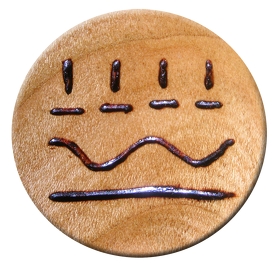
Didgeridoo maker using the Sandidg method
Didgelement, Christian, Who is he? A musician since the age of 10, I have always been fascinated by musical instruments from around the world, whether traditional or contemporary. It was therefore quite natural that I became interested in the didgeridoo when it crossed my path in 2003.
Since that day I have not stopped playing, nourishing a passion that continues to grow as I discover the incredible musical possibilities of the instrument. It was in 2006, through a meeting in Grenoble, that I began to make didgeridoos using the "sandidg" method, thus taking advantage of my passion for the craftsmanship of this noble and magical material that is wood. Since then, I have made many instruments, gradually perfecting my working methods and constantly raising my level of requirement, so as to have the best possible instruments to develop my game.
It was at the instigation of my playing friends that I decided to offer my creations for sale, with the hope of allowing other didgeridoo enthusiasts to have instruments that could satisfy their demands for excellence, both in terms of playability and sound quality, as well as originality and aesthetics.
Comment Christian makes his didgs? The design of a didgeridoo begins with the choice of wood species. The two varieties that I like the most are cherry and maple because of their aesthetic and acoustic properties, however, I also use many other local species that I can find in the forest or in clearing areas (walnut, boxwood, beech, ash, holly, fruit trees, etc.). I use the manufacturing method called "sandidg" which consists of cutting a trunk or a branch in two, and symmetrically avoiding the two parts to then glue them back together. Although I also like working from branches, most of the didgeridoos that I make are made from wooden boards that I will select in a sawmill using the same method.
The advantage of starting with beams rather than branches, apart from the fact that it is perfectly dry wood and therefore less exposed to cracks, is that instead of limiting oneself to the natural shape of the branch as is usually the case, here one can be totally creative and approach the development of the didgeridoo as that of a sound sculpture.
When making it, I first take care of designing the shape of the air column according to the desired acoustic properties and aesthetics. After gluing, my instruments are reworked in order to obtain perfect balance, impeccable playability and optimal sound quality, which will give a unique character to each didgeridoo. Then, because I consider the didgeridoo as a musical instrument that must be able to be played both solo and in a group, each of my creations is meticulously tuned both in terms of the fundamental note and the vibrations. I then give the instrument a natural side by sculpting the exterior, thus playing on the shape, the grain and other characteristic features of the wood that I strive to highlight.
I believe that our musicality develops more with a didgeridoo that we enjoy looking at and that resembles us. It is therefore essential for me that each of my creations is both a high-quality musical instrument and a unique personalized piece of craftsmanship.
Each Didgelement instrument is carefully varnished inside and out, not only for aesthetic reasons, but also for sound and durability. The keys of my mouthpieces, on the other hand, are made of polished wood to avoid any contact with the varnish, while ensuring optimal playing comfort.
Finally, for the sake of durability and transport, each of my didgeridoos has a standard Didgelement cover, carefully made in a resistant fabric and lined with foam for more protection. For the most exceptional instruments, a custom cover is made with in addition, a reinforcement at the level of the bell, a handle, as well as a balanced handle for a perfect hold. " Kriss.
Warranty: Instrument guaranteed for 2 years by Kriss: The 2-year warranty is valid from the date of delivery, it includes labor and repair of cracks, splits or air leaks. If, due to natural causes, cracks appear on your instrument, Kriss will repair it free of charge. The purchaser is required to return the instrument to DidgElement. All return shipping costs and insurance are the responsibility of the purchaser. The purchaser must contact DidgElement, before returning the didj under this warranty to receive authorization. This warranty does not cover mistreatment, neglect, misuse, abuse, accidental or otherwise of the instrument. If a didgeridoo is returned for repairs and there are visible signs of mistreatment, the purchaser will be responsible for all costs associated with repairing the instrument. Kriss.